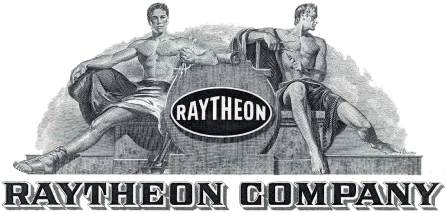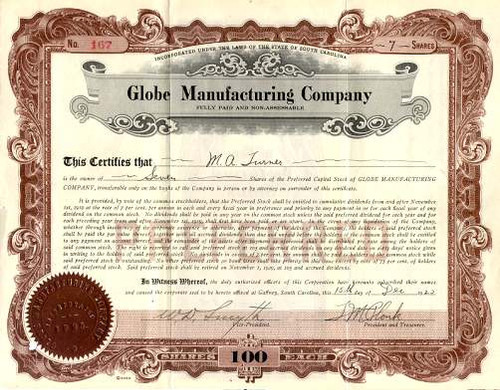Beautifully engraved certificate from the Raytheon Manufacturing Company issued in 1960-1968. This historic document was printed by the American Banknote Company and has an ornate border around it with a vignette of allegorical men with the company logo. This item has the printed signatures of the Company's President ( Charles Adams ) and Treasurer and is over 34 years old. 
Certificate Vignette Two former college roommates Laurence K. Marshall and Vannevar Bush, along with scientist Charles G. Smith, founded Raytheon Company in Cambridge, Mass., as the American Appliance Company in 1922. Throughout its more than 75-year history, Raytheon Company has been a leader in developing defense technologies and in converting those technologies for use in commercial markets. From its early days as a maker of radio tubes, its adaptation of World War II radar technology to invent microwave cooking, and its development of the first guided missile, Raytheon has successfully built upon its pioneering tradition to become a global technology leader. Raytheon Company was founded in Cambridge, Mass., as the American Appliance Company in 1922, a pivotal time in American history. The first decade of modernism, the 1920s saw the advent of automobiles, radios and refrigerators. The electrical industry was extending power lines across the United States, and telephones were linking every hamlet and home. In the aftermath of World War I, the roaring '20s was a time of flappers and flasks, and the nation was in flux, disillusioned by the end of a bitter war that brought no real peace or economic security and energized by the prospects of modern technological advances. Emerging from the depths of a severe post-war depression that wiped out jobs and forged a widening chasm between the privileged and the poor was a breed of entrepreneurs with a driving ambition to succeed and willingness to gamble on it. It is against this backdrop that the founders of Raytheon became business partners. Two former college roommates, Laurence K. Marshall and Vannevar Bush, formed the company with Charles G. Smith, a young scientist who had developed the prototype for a home refrigerator that used artificial coolants. Marshall, an engineer, businessman and trained physicist, and Bush, a scientist and professor of electrical engineering at the Massachusetts Institute of Technology, along with several other financial backers dreamed of prosperity and a potential market for their newly developed refrigerator. As is the case with so many other entrepreneurs, however, the product that launched the company was a bust and never left the laboratory. Facing failure, it was Marshall and Bush who suggested revisiting an earlier idea young Smith had experimented with: a new kind of gaseous tube that would allow radios for the first time to be plugged into a wall socket and operate on electricity rather than batteries. The tube would overcome the need for two expensive, short-lived A and B batteries, the greatest shortcoming to widespread radio use at the time. By devising a way to replace the B battery with a tube, the small company not only beat out the army of researchers and engineers of RCA, Westinghouse and other corporate giants, it produced a device that forced the entire radio industry into a new direction and made radios affordable and accessible to every household. Perfected and introduced to the public in 1925, the tube, known technically as a gaseous rectifier and marketed under the brand name Raytheon, brought in more than $1 million in sales by the end of 1926 and positioned the company as a major contributor to the fast-growing radio tube market for nearly two decades. In the more than 75 years since, the company would become known for many more major technological advancements that have changed the course of American culture and world history. Among these innovations are the first commercial microwave ovens, miniature tubes for hearing aids, the Fathometer depth sounder, the mass production of magnetron tubes, early shipboard radar, the first successful missile guidance system, a space communications system, mobile radio telephones, the first combat-proven air defense missile system and Terminal Doppler Weather Radar. In 1925, the year American Appliance Company began to take off, an Indiana company made it known that it held prior claim to the American Appliance Company name. Because of the success of the Raytheon radio tube, company officials at that time elected to extend the use of the name to describe the entire organization, and the company's name was officially changed to Raytheon Manufacturing Company. "Ray" comes from "rai," an Old French word that means "a beam of light," while "theon" comes from the Greek and means "from the gods." Furthermore, both the product and company name were deemed scientifically appropriate given groundbreaking research at the time on the mystery of the Wolf-Rayet star Zeta Puppis, which emitted bright ultraviolet lines believed to be the result of gaseous substances. Laboratory experiments by C.G. Smith on the source of these gases became the basis of crucial importance to his development of the company's radio tube. History is from Raytheon Marketing Material.

Certificate Vignette














